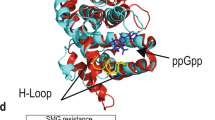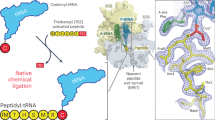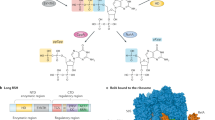Abstract
AMINO acid starvation of rel+ bacteria1 results in a rapid pleiotropic response involving the cessation of stable RNA synthesis, a decrease in the rate of nucleoside transport, an altered pattern of mRNA synthesis, inhibition of phospholipid synthesis and increased protein turnover. This stringent response2 is rapidly reversed when the amino acid starvation is relieved and is apparently mediated by two unusual nucleotides, guanosine 5′-diphosphate, 3′-diphosphate (ppGpp) and guanosine 5′-triphosphate, 3′-diphosphate (pppGpp)3. These nucleotides are synthesised on the ribosome in the presence of uncharged tRNA, ATP, GTP and an enzyme known as stringent factor3. Mutants which fail to exhibit the stringent response to amino acid starvation with the synthesis of ppGpp pppGpp are known as relaxed mutants4 and in Escherichia coli are mapped at three loci; relA (ref. 5), relB (ref. 6), and rplK (relC) (refs 7 and 8). The synthesis of ppGpp and pppGpp has also been observed in various prokaryotes including blue-green algae9. Here we demonstrate the ability of bacterial stringent factor to be stimulated by eukaryotic ribosomal preparations to synthesise both ppGpp and pppGpp.
This is a preview of subscription content, access via your institution
Access options
Subscribe to this journal
Receive 51 print issues and online access
$199.00 per year
only $3.90 per issue
Buy this article
- Purchase on Springer Link
- Instant access to full article PDF
Prices may be subject to local taxes which are calculated during checkout
Similar content being viewed by others
References
Cashel, M. & Gallant, J. in Ribosomes (eds Nomura, M., Tissières, A. & Lengyel, P.) 733–745 (Cold Spring Harb. Laboratory, 1974).
Stent, G. S. & Brenner, S. Proc. natn. Acad. Sci. U.S.A. 47, 2005–2014 (1961).
Block, R. & Haseltine, W. A. in Ribosomes (eds Nomura, M., Tissières, A. & Lengyel P.) 747–761 (Cold Spring Harb. Laboratory, 1974).
Borek, E., Ryan, A. & Rockenbach, J. J. Bact. 69, 460–467 (1955).
Alfoldi, L., Stent, G. S. & Clowes, R. C. J. molec. Biol. 5, 348–355 (1962).
Lavallé, R. Bull. Soc. Chim. Biol. 47, 1567–1570 (1965).
Friesen, J. D., Fiil, N. P., Parker, J. M. & Haseltine, W. A. Proc. natn. Acad. Sci. U.S.A. 71, 3465–3469 (1974).
Parker, J. M., Watson, R. J. & Friesen, J. D. Molec. gen. Genet. 101, 227–244 (1976).
Carr, N. G. & Mann, N. Biochem. Soc. Trans. 3, 368–373 (1976).
Hershko, A., Mamont, P., Shields, R. & Tomkins, G. M. Nature 232, 206–211 (1971).
Mamont, P. et al. Biochem. biophys. Res. Commun. 43, 1378–1384 (1972).
Richter, D. FEBS Lett. 34, 291–294 (1973).
Stanners, C. P. & Thompson, L. H. in Control of Proliferation in Animal Cells (eds Clarkson, B. & Baserga, R.) 191–203 (Cold Spring Harb. Laboratory, 1974).
Klein, C. FEBS Lett. 38, 149–152 (1974).
Rhaese, H. J. FEBS Lett. 53, 113–118 (1975).
Horváth, I., Zabos, P., Szabados, GY. & Bauer, P. FEBS Lett. 56, 179–183 (1975).
Irr, J. D., Kaulenas, M. S., Unsworth, B. R. Cell 3, 249–253 (1974).
Haseltine, W. A. & Block, R. Proc. natn. Acad. Sci. U.S.A. 70, 1564–1568 (1973).
Pedersen, F. S. in Alfred Benzon Symp. IX, Control of Ribosome Synthesis (eds Kjeldgaard, N. O. & Maaløe, O.) 419–426 (Munlsogaard, 1976).
Thompson, L. H., Harkins, J. L. & Stanners, C. P. Proc. natn. Acad. Sci. U.S.A. 70, 3094–3098 (1973).
Sy, V., Ogawa, Y. & Lipmann, F. Proc. natn. Acad. Sci. U.S.A. 70, 2145–2148 (1973).
Christiansen, L. & Nierhaus, K. H. Proc. natn. Acad. Sci. U.S.A. 73, 1839–1843 (1976).
Howard, G. A., Smith, R. L. & Gordon, J. J. molec. Biol. 106, 623–637 (1976).
Beres, L. & Lucas-Lenard, J. Biochim. biophys. Acta 395, 80–90 (1975).
Buckel, P. & Böck, A. Biochim. Biophys. Acta 324, 184–187 (1973).
Kudrna, R. & Edlin, G. J. Bact. 121, 740–742 (1975).
McMahon, D. & Langstroth, P. J. gen. Microbiol. 73, 239–250 (1972).
Thammana, P., Buerk, R. R. & Gordon, J. FEBS Lett. 68, 187–190 (1976).
Stanners, C. P. & Becker, H. J. cell. Physiol. 77, 31–42 (1971).
Author information
Authors and Affiliations
Rights and permissions
About this article
Cite this article
POLLARD, J., PARKER, J. Guanosine tetra- and pentaphosphate synthesis by bacterial stringent factor and eukaryotic ribosomes. Nature 267, 371–373 (1977). https://doi.org/10.1038/267371a0
Received:
Accepted:
Issue Date:
DOI: https://doi.org/10.1038/267371a0
This article is cited by
Comments
By submitting a comment you agree to abide by our Terms and Community Guidelines. If you find something abusive or that does not comply with our terms or guidelines please flag it as inappropriate.



